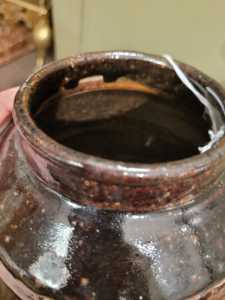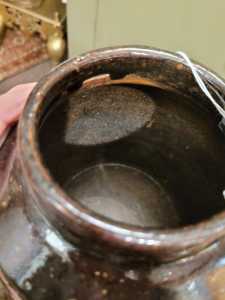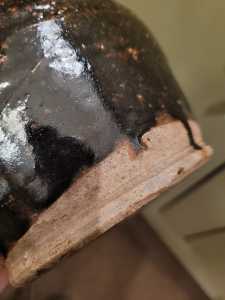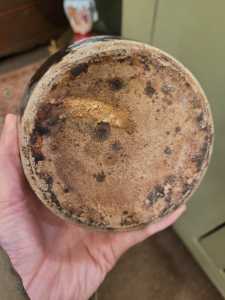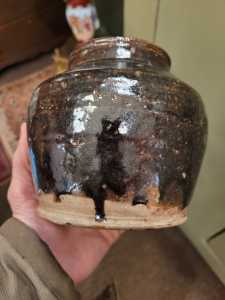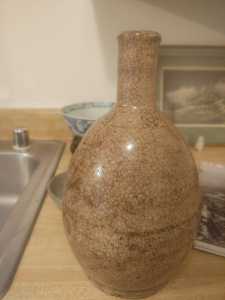The Chinese and Asian Art Forum. For Fans, Collectors and Dealers.
 Basic Rules For the BidAmount Asian Art Forum: Talk about whatever you want. You can even discuss and offer things that are for sale if they are authentic. Maximum image file size per post is 2 MB. Images of 700pxl x 700pxl are optimal if saved at a medium resolution. Be respectful of others and enjoy yourself. Click the YouTube link for a brief tutorial on using the forum. You can also EMBED Videos by cutting and pasting from You-Tube, Vimeo etc.
Basic Rules For the BidAmount Asian Art Forum: Talk about whatever you want. You can even discuss and offer things that are for sale if they are authentic. Maximum image file size per post is 2 MB. Images of 700pxl x 700pxl are optimal if saved at a medium resolution. Be respectful of others and enjoy yourself. Click the YouTube link for a brief tutorial on using the forum. You can also EMBED Videos by cutting and pasting from You-Tube, Vimeo etc.
NOTE: To post an item or add a new post, click open the category title from the FORUM LIST, and CLICK the Blue ADD TOPIC button.
@johnshoe John, that is not likely to be Song pottery. That would be considered a fairly large size for the Song period, and I would expect it to have a shape/form that was more refined to known shapes (meiping, balluster, cong, bottle, etc). It's just kind of a jar, but not a jar typical of what you see in the song, which would likely have a defined neck and shoulder, body, etc.
It has more in common with Tang dynasty wares...
https://www.christies.com/en/lot/lot-5878199
However, the brown glaze looks rather brushed on and appears to be a fairly low firing temperature, based upon the wide light spots of where the glaze seems to have parted from the clay, so I suspect this is a more modern (but not necessarily new) studio pottery that could be American, European, Japanese, or perhaps Chinese.
But, looking at the foot, it too has a low fire earthenware/clay look to it, so I suspect this is a studio piece, perhaps done in the 20th c here in the USA.
I think when the glaze falls short of the foot, the conclusion is often to assume it is of Chinese origin, but this technique has been used by potters in Europe and the USA for over a hundred years, and even modern pieces look quite old.
Take a look.
https://nyshowplace.com/products/modern-studio-art-pottery-black-glazed-jardiniere
@greeno107 Interesting insights, and a good reminder about how more modern wares can sometimes appear older than they are. But I do think this is likely an older object. In terms of shapes, I have seen a variety of Song shapes, especially of the utilitarian sort, and they vary in terms of quality, size, etc. I have one already that is quite similar. Just for kicks, here's an interesting comp for glaze/clay, colors, etc: https://www.sothebys.com/en/buy/auction/2023/the-legacy-of-hirano-kotoken/a-small-cizhou-black-glazed-ribbed-jar-northern
@johnshoe I don't see any similarity between your jar and the Sotheby's example, sorry.
Well, I think your points bring me back to two fundamental beliefs I have about assessing authenticity that not everyone shares.
1. There must be an artistic element to the piece in order to make it worthy of collection.
2. Quality is a relevant component, perhaps the most important component, of assessing authenticity, and objects lacking quality should be considered suspect unless irrefutable evidence can be provided to support authenticity (ie. TL test).
From a technical standpoint, a flat bottom like the one on your jar is not what I would be describing as 'Song' style.
I'm already feeling some regret about this post, and I've decided as a result of earlier, somewhat heated disputes, that I'm going to avoid these type of differences in opinions. Just note that I'm telling you my thoughts with good intentions.
@greeno107 no worries, I know you mean well. The other Song piece I own which I had Peter look at is also flat bottomed so that doesn't seem to be uncommon for Song objects of a certain type. It also has a similar feel in terms of proportional weight. I'm surprised you don't see the color similarities in the comp I posted. As for quality, this would be a much lower grade item, so obviously not similar in style to the comp in that regard.
@greeno107 also, another piece I forgot to mention is when Peter assessed the other similar piece he said it could be anywhere from Song to early Ming as they made such utilitarian jars in large quantities over a long period of time.
@johnshoe I'm amazed that China apparently produced such American looking pottery but I remember that Charles Bryan found a perfect comp for his black/brown glaze pot in a previous post, not that long ago. I thought it was an American bean pot, but that perfect comp changed my mind. You might be able to find it in his activity, I think it was this year.
A lot of material billed as "Americana" is heavily influenced by Asian countries. This isn't always discussed.
This, for example, reads like American Japanism to me, but is simply described as from the 19th century US.
https://high.org/collection/jug-3/
It looks quite similar to 17th century Seto ware:
Many American examples are also influenced by Song ceramics, as they often fit the American understanding of Wabi-Sabi aesthetics. Quite popular.
This enthusiasm is contemporary with famous collectors such as Charles Lang Freer, and continues in many US studios today.
@johnshoe Okay...you've pulled me back into this conversation.
Yes, of course there were utilitarian jars and such made during the Song. And as utilitarian jars and such, they got used. What do you suppose 800-900 years of use does to a jar? Does your jar exhibit this degree of use?
In my house, we can hardly keep a dinner plate for a year without chipping it. And, after just a few years, those 'signs of age' look pretty darn old.
It is not a good enough standard to say something is (or could be) Song dynasty because it 'looks old' and has some characteristics to photos of Song dynasty pieces. Everything about the piece needs to be correct for the period, utilitarian or otherwise.
Why? Because early ceramics much more easy to copy, AND more importantly, their glazes have been copied by almost every civilization over the past 300-500 years. They're generally fairly simple forms, monochromatic (mostly), and not well understood outside of what you see in books and through the glass at a museum.
To understand Song wares, you MUST handle them. The paste is far more like porcelain than clay, so they don't really feel like pottery, even if it is dark in color and granular like pottery.
The glazes are dense, even if they are tranlucent.
I'm injecting a lot of subject observations that I've made recently from my trip to Asian week. To be honest, I have never handled so many Song Yuan wares as I did last month.
As it has been pointed out, Song glazes have been studied and copied for hundreds of years, and used in a variety of countries around the world.
Your glaze actually looks like American alkaline glaze used in the 19th c. into modern times. The jar form, too, is quite inline with American wares. There are serious collectors of these American jug wares (those made by 'Dave the Slave' sell for hundreds of thousands of dollars).
Google some collectors and make an inquiry of they feel your jar is American - I think it would be informative to get input from an Amercian pottery collector... perhaps they have some tips on how to distinguish American wares from similar Chinese wares.
@greeno107 thanks for the mention of Dave the slave who I had not previously heard of. Now I have a whole other type of treasure to keep an eye open for when I'm out searching. Perhaps I'll find one of his jugs at a barn sale somewhere.
As for your point about wear representing age, I have also heard you make the opposite argument in the past, because as you have pointed out in other discussions and know very well, wear can also be faked and some old objects of all types can remain in very fine condition despite their years. But yes, I think the jar shows some signs of age. How much age? Not sure, hence my original question to all of you. I have owned some 19th c chinese pottery objects that looked ancient to me before I learned differently so I do find these earthy types a bit tricky to figure out.
At any rate, I'll take your advice and look into the area of older American pottery to see if I can learn a bit more by doing a comparison and then assess my jar from both the American and Chinese angles. This is an area I definitely want to get stronger in so it's a good excuse for a deeper dive.
Hi John, the base of your jar is similar to that one:
https://www.catawiki.com/en/l/66350107-vase-stoneware-china-song-dynasty
You also can google "brown glazed ginger jar" and you can find more like this.
The bottom is usualy very thin.
Fred
@johnshoe As for your point about wear representing age, I have also heard you make the opposite argument in the past, because as you have pointed out in other discussions and know very well, wear can also be faked and some old objects of all types can remain in very fine condition despite their years.
Yes, it sounds like a contradiction to statements I made earlier IF you do not take into account the context of my statements (at least from what I remember). If I was less clear in the past, allow me to clarify:
Imperial wares, high end commissioned mark and period pieces, and even high end export pieces were coveted items from the moment of their creation, owned by wealthy patrons, made from the best materials available, and thus, both resist normal wear, and were likely well kept to avoid damage and wear.
Finding a piece as described without damage and wear should not be evidence to exclude it from being genuine, AND a piece as described above with excessive wear/damage should be viewed with some concern - forgers definately add fake signs of age.
However, a utilitarian piece of almost any age should show signs of use, unless it was among a sunken cargo at the bottom of the ocean, in which case, it should show signs of being lost at sea. And, a utilitarian piece of significant age, should show significant signs of use.
Thanks for visiting "The BidAmount Asian Art Forum | Chinese Art"
If you sell on eBay, or have a shop feel free to post images and descriptions and links.
Check back often for discussion about the latest news in the Chinese art and antique world. Also find out about the latest Asian art auctions at Sotheby's, Christie's, Bonhams and Tajans.
Auction results for: fine porcelain, ceramics, bronze, jade, textiles and scholar's objects. As well as Japanese, Thai, Vietnamese and other Asian cultures.
Thank you,
Peter Combs
Topics and categories on The BidAmount Asian Art Forum | Chinese Art
Kangxi vases, Kangxi dishes and chargers, Kangxi ritual pieces, Kangxi scholar's objects, Qianlong famille rose, Qianlong enamels, Qianlong period paintings, Qianlong Emporer's court, Fine porcelain of the Yongzheng period. Chinese imperial art, Ming porcelain including Jiajing, Wanli, Xuande, Chenghua as well as Ming jades and bronzes.
The BidAmount Asian Art Forum | Chinese Art
A free Asian art discussion board and Asian art message board for dealers and collectors of art and antiques from China, Japan, Korea, Thailand, Cambodia, Vietnam and the rest of Asia. Linked to all of the BidAmount Asian art reference areas, with videos from plcombs Asian Art and Bidamount on YouTube. Sign up also for the weekly BidAmount newsletter and catalogs of active eBay listing of Chinese porcelain, bronze, jades, robes, and paintings.
The art of calligraphy - and for the ancient Chinese it certainly was an art - aimed to demonstrate superior control and skill using brush and ink. Calligraphy established itself as one of the major Chinese art forms during the Han dynasty (206 BCE - 220 CE), and for two millennia after, all educated men were expected to be proficient at it.
The Museum’s collections of Asian art span nearly five millennia and encompass the cultures of China, the Himalayas, India, Japan, Korea, and Southeast Asia. In 2007, the Museum launched an initiative to create dedicated galleries for the collection, beginning with a gallery for the arts of Korea ...
Chinese art is full of symbolism, in that artists typically seek to depict some aspect of a totality of which they are intuitively aware.
China Online Museum is the finest online museum of Chinese art. It features Chinese calligraphy, painting, ceramics, bronzes, carving, and other artworks.
Chinese Ceramics & Works of Art. Overview Upcoming auctions Contacts Auction results ... Christie’s sales of Chinese ceramics and works of art showcase centuries of Chinese history. Held throughout the year in London, New York, Paris and Hong Kong, they attract a wide audience of collectors and connoisseurs vying for pieces as diverse as ...
Explore Asian Art Week. Contact the Specialist Department. Chinese Paintings ... Senior Specialist, Head of Sale. [email protected]. Tel:+1 212 641 5760. Bid in-person or online for the upcoming auction:Fine Chinese Paintings on 10 September 2019 at New York. Bid in-person or online for the upcoming auction:Fine Chinese Paintings on 10 ...
Discover an abundance of must-see art from all corners of a vast continent at Christie’s NY Asian Art Week. From contemporary classical and Chinese paintings to works with exemplary provenance from the Art Institute of Chicago, our Rockefeller Paza galleries will be full of ancient treasures and contemporary masterworks in a salute to the vibrant arts of Asia.
Sold to benefit The Art Institute of Chicago’s Asian Art Acquisition Fund, the sale features 84 lots with a focus on Ming and Qing porcelains, and offers a rare insight into the taste for collecting Chinese ceramics and works of art in the Midwest from the end of the 19th century through the 1980s. Highlights include two Wanli wucai garlic-head vases, a Qianlong mark and period, blue and ...
Specialist, Chinese Paintings, Christie's London Dr Malcolm McNeill is a Specialist in Chinese Paintings at Christie’s, based in London. He previously worked as an assistant curator of the Chinese collections and the Victoria and Albert Museum in London, as a researcher at the British Museum, and as a translator and tour guide at the National Palace Museum in Taipei.
The Christie's Education 2020 Conference: The Chinese Art Market 18 Jun 2019 Christie’s Education is delighted to announce our first international academic conference in Asia which will take place in Hong Kong from 26-27 November 2020 at the Hong Kong Convention and Exhibition Centre and will run in parallel with Christie’s Hong Kong Autumn Auctions.
The summer Chinese Art sale in Hong Kong will feature works of art from several private collections, including Qing porcelains and textile from the collection of the legendary Chinese art dealer A. W. Bahr (1877–1959), fine gilt bronze Buddhist sculptures from an old Hong Kong collection, an East Asian collection of Qing dynasty wine cups and jades, and a Japanese collection of Song ceramics ...
Sotheby's Chinese Works of Art Department holds two auctions each year in London, New York, Hong Kong and Paris.
Chinese Art - View Auction details, bid, buy and collect the various artworks at Sothebys Art Auction House.
With more than 340 Chinese works of art dating from the Neolithic to the Republic periods, highlights of this sale include a selection of Qing Imperial monochromes from the collection of Arnold and Blema Steinberg, early ceramics from the Art Institute of Chicago and Chinese porcelain and works of art from the collection of Henry Arnhold.
Results: Sotheby's Asia Week achieved $52.4 million in six strong auctions, exceeding pre-sale estimates. With 76.5% of lots sold and 60.3% of lots surpassing high estimates, the Asian art sales at Sotheby's indicate continued collector interest in the finest works of art from China, India and and the Himalayas.
Today's sale of Important Chinese Art will proceed as planned with sessions at 10 AM and 2 PM EDT. Sotheby's will be monitoring the weather conditions throughout the day and will be available to coordinate alternative bidding options should conditions make it difficult for clients to attend the auction in person.
Bonhams Chinese Art department is renowned for offering the finest works of art representing the richness and breadth of China's artistic heritage, particularly Imperial porcelain, white and spinach green jades, cloisonné and Buddhist art. Specialised international auctions are held globally, including London, Hong Kong and San Francisco.
Bonhams : Chinese Works of Art We use cookies to remember choices you make on functionality and personal features to enhance your experience to our site. By continuing to use our site you consent to the use of cookies. Please refer to our privacy and cookie policies for more information.
Bonhams Fine Art Auctioneers & Valuers: auctioneers of art, pictures, collectables and motor cars. We use cookies to remember choices you make on functionality and personal features to enhance your experience to our site. By continuing to use our site you consent to the use of cookies. ... Chinese Art (US) General enquiries
Bonhams : Fine Chinese Art We use cookies to remember choices you make on functionality and personal features to enhance your experience to our site. By continuing to use our site you consent to the use of cookies. Please refer to our privacy and cookie policies for more information.
Bonhams Fine Art Auctioneers & Valuers: auctioneers of art, pictures, collectables and motor cars Bonhams : Asian Art We use cookies to remember choices you make on functionality and personal features to enhance your experience to our site.
Bonhams are international auctioneers of fine Chinese and Japanese art. We specialise in rare Imperial and Export Chinese ceramics and works of art, as well as Japanese ceramics, fine and decorative works of art from the Neolithic Period to the 20th century. View on map
Bonhams Fine Art Auctioneers & Valuers: auctioneers of art, pictures, collectables and motor cars. We use cookies to remember choices you make on functionality and personal features to enhance your experience to our site. By continuing to use our site you consent to the use of cookies. ... Asian Art Bonhams. Work. 22 Queen St.
